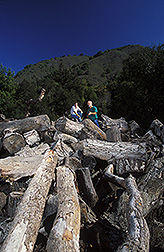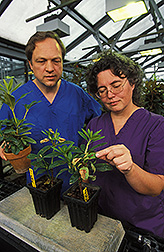Sudden Oak Death:
ARS Scientists Fight Back!
|
|
Sudden oak death—a mostly mysterious disease—afflicts not only these majestic hardwoods but also many other trees and shrubs, including backyard favorites like azaleas, camellias, and rhododendrons.
The disease has menaced California's scenic oak woodlands since the mid-1990s. It's caused by a little-known funguslike microbe named Phytophthora ramorum, which also causes several diseases of ornamentals, including ramorum blight and ramorum die-back, most of which aren't lethal.
This pathogen has now been detected in plant nurseries in 20 states. One result: at least half a million otherwise ready-to-sell plants have had to be destroyed to help stop the pathogen's spread.
On both coasts, ARS plant pathologists—experts in diseases that affect plants—have teamed up with colleagues to discover what can be done to defeat this marauding microbe. Their work is helping America's $14 billion nursery industry and, of course, also benefits everyone who enjoys the beauty, color, and tranquility that ornamental trees and shrubs bring to home gardens, balcony planter boxes, and parks.
|
|
DNA Technology Identifies the Culprit
To clobber a powerful plant pathogen like P. ramorum, you need a fast, accurate way to tell it apart from other suspicious microbes. A DNA-based assay was designed by ARS plant pathologists Frank N. Martin in Salinas, California, and Paul W. Tooley in Fort Detrick, Maryland, to do exactly that. They did the work in collaboration with plant pathologist Cheryl L. Blomquist of the State of California's Department of Food and Agriculture.
Their species-specific test relies on a sophisticated yet increasingly common technology known as PCR (polymerase chain reaction). The assay determines whether a piece of a leaf, for example, contains telltale genetic material from this species of microbe. Importantly, many technicians in plant-health labs across the country already have the skills and equipment to run the test.
In 2004, the scientists turned their test over to California agriculture officials and USDA's Animal and Plant Health Inspection Service for possible use with other molecular diagnostic methods.
Martin, who's with the ARS Crop Improvement and Protection Research Unit, and Tooley, at the Foreign Disease-Weed Science Research Unit, are developing more assays to further clarify who's who among Phytophthora's many microbe members. Details are on the web at http://pwa.ars.usda.gov/salinas/cipru/frank/phyto.htm.
Resistant or Susceptible?
Researchers such as Tooley and ARS plant pathologist Robert G. Linderman in Corvallis, Oregon, are probing P. ramorum's differing effects on various kinds of popular woody ornamental plants—and some small fruits, as well.
Based at the ARS Horticultural Crops Research Unit, Linderman works with ARS plant pathologist Niklaus J. Grunwald and Oregon State University post-doc Steven Scheuerell, investigating how western U.S. nurseries typically grow familiar plants—mainly rhododendrons, viburnums, and lilacs. Tooley and collaborators delineate the pathogen's prowess in attacking East Coast nursery crops.
Linderman's experiments showed that many more western nursery crops than expected are susceptible. His group determines a plant's vulnerability by inoculating detached leaves with the pathogen.
"We've seen how easy it could be to overlook mild or minimal symptoms," Linderman points out, "or to misdiagnose plants that have symptoms similar to those of this newly emerging disease."
The East Coast team of Tooley, research associate Kerrie L. Kyde of the Maryland Department of Natural Resources, and Larry Englander of the University of Rhode Island have tested more than 50 members of the Ericaceae family, which includes some small berries as well as rhododendrons and azaleas. They ranked cranberries and highbush blueberries among the most resistant and published their findings in the September 2004 issue of Plant Disease.
Color photos taken by Tooley and Kyde offer a first-time glimpse of sudden oak death disease symptoms on many popular East Coast species. The images are available on CD-ROM and have also been posted by the North Central Integrated Pest Management Center on the World Wide Web at www.ncpmc.org.
Finding the Best Fungicides
At both Corvallis and Fort Detrick, finding the best fungicides to quell P. ramorum is a top priority. Linderman, for example, was among several researchers to find that a familiar fungicide, Subdue Maxx, could help control P. ramorum.
"While it doesn't kill the microbe outright," says Linderman, "it does a dramatically good job of suppressing it when applied as a soil drench." That's unlike most other fungicides, which are applied as sprays. He found that Subdue Maxx is effective against several other Phytophthora species as well and considers it "the fungicide of choice until some of the newer chemicals can be more thoroughly evaluated."
"Most of the systemic fungicides now used as sprays don't kill P. ramorum," agrees ARS plant pathologist Nina Shishkoff at Fort Detrick. "They just suspend the microbe's growth and perhaps mask its symptoms."
For example, tiny dark spots on leaves—called lesions—might go unnoticed until later in the infection, when they expand. "We need to understand what happens to P. ramorum when you spray these chemicals," says Shishkoff. To that end, she's spraying rhododendrons with three different kinds of systemic fungicides and monitoring the chemicals' effects on the pathogen's persistence and infectivity.
Pots and Planting Mixes: Pathogen's Playground?
Besides eluding certain fungicides, P. ramorum may also be able to survive in nursery containers and planting mixes—also called potting soil—thus boosting its ability to spread from one locale to the next. "In some jurisdictions," explains Linderman, "plant-health inspectors will destroy infected plants but will keep the containers. But even after the pots are washed, the pathogen could still survive in them."
His team's experiments with air-steam combinations may determine which temperatures are hot enough to kill the pathogen without damaging the containers—which are generally made out of plastic.
Shishkoff, meanwhile, intends to unearth new information about P. ramorum's life underground, particularly its potential to infect roots.
Every detail that these researchers uncover will go a long way toward protecting prized trees, shrubs, and berry plants against this problematic pathogen.—By Marcia Wood, David Elstein, and Jan Suszkiw, Agricultural Research Service Information Staff.
This research is part of Plant Diseases, an ARS National Program (#303) described on the World Wide Web at www.nps.ars.usda.gov.
Frank N. Martin is with the USDA-ARS Crop Improvement and Protection Research Unit, 1636 E. Alisal St., Salinas, CA 93905; phone (831) 755-2873, fax (831) 755-2814.
Paul W. Tooley and Nina Shishkoff are in the USDA-ARS Foreign Disease-Weed Science Research Unit, 1301 Ditto Ave., Fort Detrick, MD 21702; phone (301) 619-2632 [Tooley], (301) 619-2877 [Shishkoff], fax (301) 619-2880.
Robert G. Linderman is in the USDA-ARS Horticultural Crops Research Unit, 3420 N.W. Orchard Ave., Corvallis, OR 97330; phone (541) 738-4062, fax (541) 738-4025.
"Sudden Oak Death: ARS Scientists Fight Back!" was published in the February 2005 issue of Agricultural Research magazine.









